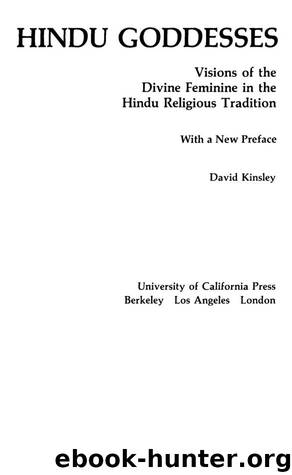Hindu Goddesses by Kinsley David R

Author:Kinsley, David R.
Language: eng
Format: epub
Publisher: University of California Press
A worn-out old man, distasteful to the sight, sluggish in love’s art,
if he but fall within a side glance from you, there run after him by the hundreds,
with hair ribbons flying loose and clothes slipped from their jarlike breasts,
young women, their girdles violently bursting and their garments dropped down.22
Several names in the Lalitā-sahasranāma stress the Devī’s physical beauty or her association with sexual vitality: the beautiful one (Ramyā, 307), loveliness (Kāntā, 329), she who has beautiful eyes (Vāmanayanā, 332), she who has beautiful hair (Vāmakesī, 351), she whose form is Rati (Ratirūpā, 315; Rati is the wife of the god Kāma; her name literally means “sexual intercourse”), the one who is desired (Kāmyā, 321), she who is filled with the erotic sentiment (Sṛṅgārarasasaṁpūrṇā, 376), she whose form is the desire of women (Lolākṣīkāmarūpiṇī, 454), she who causes emotion (Kṣobhiṇī, 466), enchantress (Mohinī, 562), she whose form is sexual desire (Kāmarūpiṇī, 796), and she who overflows with desire and pleasure (Kāmakelitaraṅgitā, 863).
The Devī’s association or identification with life and the rhythms of the physical world is clear in her aspect as instigator of desire. As prakṛti and śakti, the Devī impels creation forward. In the Lalitā-sahasranāma she is called vitality (Ojovatī, 767), she who gives life (Prāṇadā, 783), and she whose form is life (Prāṇarūpiṇī, 784). The immediate, dramatic, forceful expression of this impulse is sexual attraction, which characterizes most created beings and often powerfully dominates human beings. Although the male deity Kāma is traditionally given the role of instigator of sexual desire in Hindu mythology, the Devī nonetheless is often celebrated as manifesting herself wherever sexual desire appears. In the texts that praise her, Kāma acts as her agent and is empowered by her sexual vitality.23
The Devī’s association with nourishment and food is another of her distinctive characteristics. As she is often identified with the earth itself (she is called Mahī and Dharā, “earth,” in the Lalitā-sahasranāma, 718 and 955) it is not surprising that the Devī is also identified with food, which comes from the earth. The Lalitā-sahasranāma calls her she who gives food (Annadā, 669) and nourishment (Puṣṭi, 444). Texts celebrating the Mahādevī relate a myth concerning a great drought that resulted in a dreadful famine.24 In desperation the Brahmans approached the Devī and begged her for relief. The Devī obligingly appeared in a form having many eyes. Seeing the pitiful condition of her creatures, she began to weep. She cried for nine nights, causing heavy rains to fall on the earth from her eyes. The rivers again flowed, the lakes and ponds were filled, and life once more returned to the earth in abundance.25 In this manifestation she is called Satākṣī (she who has one hundred eyes), śākambharī (she who bestows vegetables), and Annapūrṇā (she who is full of food). Images of Satākṣī show her carrying various kinds of food.26 Images of Annapūrṇā typically show her holding a cooking pot and spoon.27 Her most popular festival in Banaras takes place in the fall and celebrates her role as the sustainer of life.
Download
This site does not store any files on its server. We only index and link to content provided by other sites. Please contact the content providers to delete copyright contents if any and email us, we'll remove relevant links or contents immediately.
| Clergy | Devotionals |
| Faith | Inspirational |
| Meditations | Monasticism & Asceticism |
| Prayer | Prayerbooks |
| Ritual | Sermons |
More Language of Letting Go: 366 New Daily Meditations by Melody Beattie(2463)
The Holy Spirit by Billy Graham(2442)
To Light a Sacred Flame by Silver RavenWolf(2366)
The Secret Power of Speaking God's Word by Joyce Meyer(2268)
Tuesdays With Morrie by Mitch Albom(2187)
The Lost Art of Good Conversation by Sakyong Mipham(2135)
The Traveler's Gift by Andy Andrews(2025)
Kundalini by Gopi Krishna(1833)
A Kingsbury Collection by Karen Kingsbury(1730)
Finding Chika by Mitch Albom(1654)
Angels of God: The Bible, the Church and the Heavenly Hosts by Mike Aquilina(1638)
As a Man Thinketh by James Allen(1587)
Angels by Billy Graham(1560)
The Yoga of Jesus: Understanding the Hidden Teachings of the Gospels by Paramahansa Yogananda(1535)
Curse Tablets and Binding Spells from the Ancient World by Gager John G.;(1520)
Barking to the Choir by Gregory Boyle(1513)
Autobiography of a Yogi (Complete Edition) by Yogananda Paramahansa(1499)
How To Be Born Again by Billy Graham(1413)
Anxious for Nothing by Max Lucado(1412)
